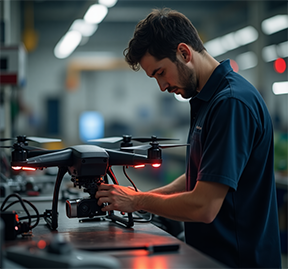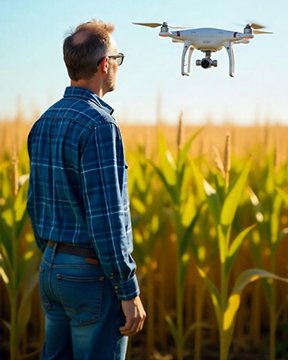Published: February 23, 2016 | Updated: September 30, 2025
Published: February 23, 2016 | Updated: September 30, 2025
The Indispensable Role of CMMS in Modern Drone Maintenance
 The proliferation of drones across various industries presents unique challenges, particularly in maintaining these sophisticated aerial vehicles. Ensuring the airworthiness and operational readiness of a drone fleet demands meticulous tracking and proactive maintenance strategies. A Computerized Maintenance Management System (CMMS) emerges as a pivotal tool in this landscape, offering a centralized platform to manage the complexities of drone upkeep. This discussion delves into the indispensable role of CMMS in modern drone maintenance.
The proliferation of drones across various industries presents unique challenges, particularly in maintaining these sophisticated aerial vehicles. Ensuring the airworthiness and operational readiness of a drone fleet demands meticulous tracking and proactive maintenance strategies. A Computerized Maintenance Management System (CMMS) emerges as a pivotal tool in this landscape, offering a centralized platform to manage the complexities of drone upkeep. This discussion delves into the indispensable role of CMMS in modern drone maintenance.
Centralized Asset Management for Drone Fleets
Managing a fleet of drones involves tracking numerous assets, each with its own maintenance requirements, flight logs, and regulatory obligations. A CMMS provides a comprehensive database to catalog each drone, its components, and associated documentation. This centralized system allows for quick access to critical information, such as purchase dates, warranty details, and maintenance history.
Consider the benefits of easily accessing the FAA drone registration information directly within the maintenance record. This level of organization proves invaluable for compliance and efficient operations.
Detailed Equipment Records
Within the CMMS, each drone possesses a detailed equipment record. This record includes specifications, serial numbers, installed components (like Sony drone cameras or specific BlueNRG microcontrollers), and their individual maintenance schedules. Tracking component-level maintenance becomes significantly easier, allowing for proactive replacements based on usage or time intervals. This granular approach minimizes downtime and maximizes the lifespan of individual drone parts.
Proactive Maintenance Scheduling and Task Management
Reactive maintenance can lead to unexpected downtime and costly repairs. A CMMS empowers proactive maintenance through scheduled tasks based on flight hours, calendar dates, or specific usage metrics. The system automatically generates work orders, assigns them to technicians, and tracks their progress. Imagine setting up recurring maintenance tasks based on the EASA guidelines for drone airworthiness. This ensures adherence to regulatory requirements and prevents minor issues from escalating into major problems.
Discover how streamlined maintenance processes can elevate production. Learn more.
Automated Work Order Generation
The CMMS automates the creation of work orders based on predefined schedules or triggered events. When a drone reaches a specific flight hour threshold, the system automatically generates a work order for the necessary inspection or maintenance. This reduces the risk of human error and ensures that no critical maintenance task gets overlooked. Technicians receive notifications about their assigned tasks, along with detailed instructions and relevant documentation, potentially including links to FAA Advisory Circulars related to drone maintenance.
Technician Assignment and Tracking
Efficient task management involves assigning the right technician with the necessary skills to each work order. The CMMS allows administrators to track technician availability, skill sets, and workload. This ensures optimal resource allocation and timely completion of maintenance tasks. Real-time tracking of work order status provides visibility into the maintenance process, allowing for proactive intervention if delays occur. Consider how this helps manage maintenance across a geographically dispersed team, especially when dealing with large-scale drone operations like those used in drone-based logistics.
Comprehensive Maintenance History and Reporting
A CMMS maintains a detailed history of all maintenance activities performed on each drone. This includes dates of service, tasks completed, parts replaced, and technician notes. This historical data proves invaluable for identifying trends, predicting potential failures, and making informed decisions about maintenance strategies and equipment upgrades. Analyzing past maintenance records can reveal recurring issues with specific drone models or components, prompting investigations and potential design improvements, drawing insights similar to those used in NASA's historical aircraft maintenance practices.
Failure Analysis and Trend Identification
By analyzing historical maintenance data, organizations can identify common failure points and recurring issues. This information allows for targeted preventative measures and potential modifications to maintenance schedules. For example, if a specific motor consistently fails after a certain number of flight hours, the maintenance schedule can incorporate more frequent inspections or replacements of that component. This approach enhances the reliability and availability of the drone fleet.
Regulatory Compliance and Audit Trails
The aviation industry operates under stringent regulatory requirements. A CMMS aids in maintaining compliance by providing a comprehensive audit trail of all maintenance activities. This documentation proves crucial during inspections and audits by regulatory bodies. Easy access to maintenance records and adherence to scheduled maintenance demonstrate a commitment to safety and regulatory compliance, aligning with standards set by organizations like the International Civil Aviation Organization (ICAO).
Inventory Management for Drone Parts
Efficient drone maintenance relies on having the right parts available when needed. A CMMS integrates inventory management, allowing organizations to track the stock levels of critical spare parts, consumables, and tools. The system can generate purchase requests when inventory levels fall below a minimum threshold, preventing delays in maintenance due to missing parts. This capability becomes increasingly important for operations that require specialized drone components, such as those used in GIS mapping with drones.
Automated Reordering and Stock Control
The CMMS can automate the reordering process for critical spare parts when stock levels are low. This ensures a continuous supply of necessary components and minimizes downtime. Effective stock control within the CMMS also helps prevent overstocking, reducing storage costs and the risk of parts becoming obsolete. This balanced approach to inventory management contributes significantly to the overall efficiency of drone maintenance operations.
Extending Drone Lifespan and Reducing Costs
Implementing a CMMS contributes directly to extending the operational lifespan of drone assets. Proactive maintenance, timely repairs, and the use of genuine or approved replacement parts help preserve the integrity of the drones. By preventing major failures and minimizing downtime, a CMMS ultimately reduces the overall cost of drone ownership and operation. Consider the long-term savings achieved by adhering to manufacturer-recommended maintenance schedules, often detailed in documents similar to Boeing's parts and services documentation, adapted for drone technology.
Informed Decisions Through Specialized Reports for Fleet Management
The data collected and analyzed by the CMMS provides valuable insights for strategic fleet management decisions. Organizations can use this information to evaluate the performance and reliability of different drone models, identify cost-effective maintenance practices, and plan for future drone acquisitions. This data-driven approach ensures that investment decisions are informed by real-world operational experience.
 Mobile Accessibility for Field Technicians
Mobile Accessibility for Field Technicians
Many CMMS solutions offer mobile applications that empower field technicians with real-time access to critical information. Technicians can view assigned work orders, access equipment history, update work order status, and even order parts directly from their mobile devices. This mobile capability enhances efficiency, improves communication, and allows technicians to perform their tasks more effectively, especially in remote operating environments often encountered in drone-based agriculture.
Real-Time Updates and Communication
Mobile CMMS access facilitates real-time updates on work order progress and any issues encountered during maintenance. This allows for seamless communication between field technicians and the maintenance management team, enabling quicker decision-making and resolution of problems. Improved communication minimizes delays and ensures a more coordinated maintenance effort.
In conclusion, a CMMS transcends the role of a mere record-keeping system in drone maintenance. It acts as a central nervous system, orchestrating every aspect of upkeep from initial asset registration to long-term strategic planning. By embracing this technology, organizations that rely on drones can ensure the continued safety, efficiency, and longevity of their aerial fleets, paving the way for sustained operational success in an increasingly drone-centric world.
FAQs
What makes CMMS essential for drone maintenance?
A CMMS centralizes all drone asset data—flight logs, parts, maintenance schedules, and compliance records—so organizations can maintain airworthiness and streamline fleet management.
How does CMMS support proactive drone upkeep?
By scheduling tasks based on flight hours, usage metrics, or regulatory requirements, CMMS helps prevent failures before they occur. It automatically generates and assigns work orders, minimizing downtime and costly repairs.
Can CMMS help with regulatory compliance for drones?
Yes. CMMS creates detailed audit trails of all inspections, repairs, and part replacements. This documentation supports compliance with standards from bodies like the FAA, ICAO, or EASA.
How does MAPCON assist with drone part inventory and replacement cycles?
MAPCON tracks drone components, stock levels, and reorder points. For advanced needs—such as managing repairable components like motors or propellers—clients may require assistance from MAPCON to configure custom workflows.
Does CMMS improve communication for field technicians?
Absolutely. With mobile access, technicians can view work orders, update status, order parts, and log issues in real time, ensuring faster response and stronger coordination—even in remote areas.
Why should drone operators choose MAPCON for maintenance management?
MAPCON offers a proven, customizable CMMS that adapts to drone operations. From compliance tracking to inventory management and mobile access, MAPCON empowers drone fleets to stay reliable, safe, and cost-efficient.
MAPCON | 800-922-4336
MAPCON CMMS software empowers you to plan and execute PM tasks flawlessly, thanks to its wealth of features and customizable options. Want to see it for yourself? Click the button below to get your FREE 30-day trial of MAPCON!
Try It FREE!